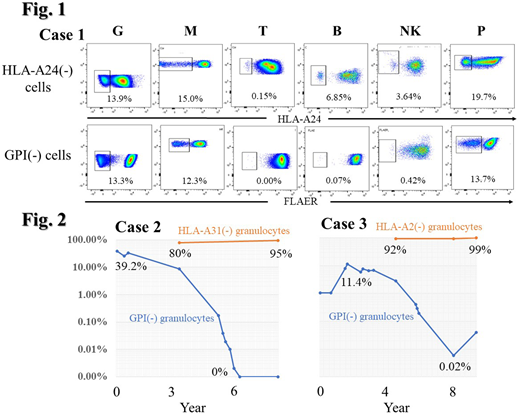Abstract
[Background] Hematopoietic stem progenitor cells (HSPCs) with PIGA mutations are thought to acquire a survival advantage over normal HSPCs under immune attack against HSPCs and produce glycosylphosphatidylinositol-anchored protein-deficient (GPI[-]) cells in patients with acquired aplastic anemia (AA). Various underlying mechanisms of the survival advantage of PIGA-mutated HSPCs have been proposed; however, it remains still unclear how PIGA-mutated HSPCs are immunologically selected in AA. Approximately 15% of AA patients with increased GPI(-) cells possess another aberrant leukocyte subset that lacks the expression of the HLA-class I allele due to a copy number-neutral loss of heterozygosity of the HLA haplotype, which occurs in the short arm of chromosome 6 (6pLOH) as a result of uniparental disomy, or HLA allelic mutations. The presence of HLA-class I allele-lacking leukocytes (HLA-LLs) is considered to be the most compelling evidence to support the involvement of cytotoxic T lymphocytes (CTLs) in the development of bone marrow failure. Charactering GPI(-) leukocytes and platelets in AA patients with HLA-LLs may provide an insight into the mechanism underlying the immune selection of PIGA-mutated HSPCs.
[Patients and Methods] We investigated the presence of GPI(-) leukocytes, erythrocytes, and platelets in 63 patients with AA using high-sensitivity flow cytometry (FCM). For the platelet analysis, platelet rich plasma (PRP) was obtained by centrifuging anticoagulated blood at 1000 rpm for 7 minutes with the brake turned off. Thirty microliters of PRP was incubated with monoclonal antibodies specific to CD55-PE, CD59-PE, CD41a-APC and HLA-A2 or A24-FITC for 20 minutes at room temperature in the dark. To prevent doublets, samples were diluted 1 to 100 in PBS and filtered with mesh immediately before the FCM analysis. Thirty of the 63 patients were heterozygous for the HLA-A allele with A24 and A2, and thus the presence of both HLA-LLs and HLA-A allele-lacking platelets could be evaluated by FCM. The lack of the HLA-A allele due to 6pLOH or allelic mutations in all HLA-LL(+) patients was confirmed by a droplet digital PCR or deep sequencing.
[Results] Increased GPI(-) granulocytes, which accounted for 0.01-99.8% of the total granulocytes, were detected in 37 (58.7%) patients while HLA-A24 or A2-lacking granulocytes accounted for 0.39-98.3% of the total granulocytes in 20 (66.7%) of the 30 patients. Eight patients possessed both GPI(-) cells and HLA-LLs. In all 8 of these patients, the two aberrant cell populations were mutually exclusive. The analyses of different cell lineages revealed HLA-A allele-lacking cells in all lineages of cells, including granulocytes (Gs), monocytes (Ms), T cells (Ts), B cells (Bs), NK cells (NKs), and platelets (Ps) in 7 of the 8 patients; the remaining one patient had the GMTP pattern. In contrast, the lineage diversity of GPI(-) in the 8 patients was more restricted; GMTBNKP was only detected in 2 patients; the combinations in the other 6 patients were GT (n=1), GMBNKP (n=2), GMTNKP (n= 1) and GMTBP (n= 2). In Case 1, GPI(-) cells were not detected in T cells while HLA-A24(-) cells were detected in all lineages of cells including T cells (Figure 1). The limited lineage diversity of GPI(-) cells was also evident in 6 patients who did not possess HLA-LLs (GMP, GMBP, GMBNKP, GMTNKP, GMTBP) with GPI(-) granulocytes>10% while the GMTBNKP pattern was common in 10 HLA-LL(+) patients who did not possess GPI(-) cells, regardless of their percentage of HLA-A allele-lacking granulocytes. Longitudinal follow-up of 5 patients over a period of 8-27 years showed a decline in the percentage of GPI(-) granulocytes (39.2 to 0.00%, 11.4 to 0.04%, 3.50 to 0.30%, 1.77 to 0.00% and 0.79 to 0.11%) and a reciprocal increase in the percentage of HLA-A allele-lacking granulocytes (80.0 to 95.2%, 92.0 to 99.1%, 24.0 to 24.4%) in 3 patients who had been placed under observation; in two patients (Cases 2 and 3) whose GPI(-) granulocyte percentages had been >10%, the PNH clones were completely replaced by HLA-LL clones during 6 and 8 years, respectively (Figure 2).
[Conclusions] The limited diversity of the blood cell lineage and spontaneous decline of GPI(-) cells that coexisted with HLA-LLs suggest that GPI(-) cells are derived from the PIGA-mutated hematopoietic progenitor cells that were allowed to proliferate as a bystander in the environment where the CTL attack against HSPCs is taking place.
Nakao:Novartis: Honoraria; Alexion Pharmaceuticals, Inc.: Consultancy, Honoraria; Kyowa Hakko Kirin Co., Ltd.: Honoraria.
Author notes
Asterisk with author names denotes non-ASH members.


This feature is available to Subscribers Only
Sign In or Create an Account Close Modal